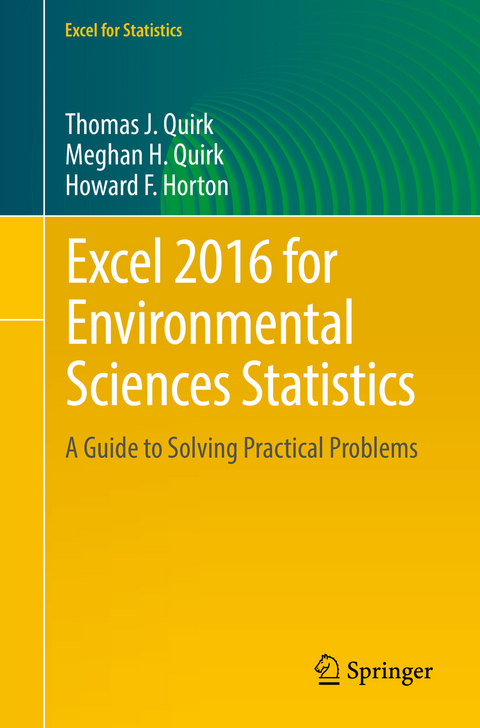Excel 2016 for Environmental Sciences Statistics
Springer International Publishing (Verlag)
978-3-319-40056-3 (ISBN)
- Titel erscheint in neuer Auflage
- Artikel merken
Excel, a widely available computer program for students and managers, is also an effective teaching and learning tool for quantitative analyses in environmental science courses. Its powerful computational ability and graphical functions make learning statistics much easier than in years past. However, Excel 2016 for Environmental Sciences Statistics: A Guide to Solving Practical Problems capitalizes on these improvements by teaching students and managers how to apply Excel to statistical techniques necessary in their courses and work.
Each chapter explains statistical formulas and directs the reader to use Excel commands to solve specific, easy-to-understand environmental science problems. Practice problems are provided at the end of each chapter with their solutions in an appendix. Separately, there is a full Practice Test (with answers in an Appendix) that allows readers to test what they have learned.
At the beginning of his academic career, Prof. Tom J. Quirk spent six years in educational research at The American Institutes for Research and Educational Testing Service. He then taught Social Psychology, Educational Psychology, General Psychology, Marketing, Management, and Accounting at Principia College, and is currently a Professor of Marketing in the George Herbert Walker School of Business & Technology at Webster University based in St. Louis, Missouri (USA) where he teaches Marketing Statistics, Marketing Research, and Pricing Strategies. He has written 60+ textbook supplements in Marketing and Management, published 20+ articles in professional journals, and presented 20+ papers at professional meetings. He holds a B.S. in Mathematics from John Carroll University, both an M.A. in Education and a Ph.D. in Educational Psychology from Stanford University, and an M.B.A. from The University of Missouri-St. Louis.Dr. Meghan H. Quirk holds both a Ph.D. in Biological Education and an M.A. in Biological Sciences from the University of Northern Colorado (UNC) and a B.A. in Biology and Religion at Principia College in Elsah, Illinois. She has done research on foodweb dynamics at Wind Cave National Park in South Dakota and research in agro-ecology in Southern Belize. She has co-authored an article on shortgrass steppe ecosystems in Photochemistry & Photobiology. She was a National Science Foundation Fellow GK-12, and currently teaches in Bailey, Colorado.Howard F. Horton holds an MS in Biological Sciences from the University of Northern Colorado (UNC) and a BS in Biological Sciences from Mesa State College. He has worked on research projects in Pawnee National Grasslands, Rocky Mountain National Park, Long Term Ecological Research at Toolik Lake, Alaska, and Wind Cave, South Dakota. He has co-authored articles in Th e International Journal of Speleology and Th e Journal of Cave and Karst Studies. He was a National Science Foundation Fellow GK-12, and a District Wildlife Manager with the Colorado Division of Parks and Wildlife. He is currently the Angler Outreach Coordinator for Colorado Parks and Wildlife (USA).
lt;p>Introduction.- Sample size, mean, standard deviation, standard error of the mean.- Random number generator.- Confidence interval about the mean using the TINV function and hypothesis testing.- One-group t-test for the mean.- Two-group t-test of the difference of the means for independent groups.- Correlation and simple linear regression.- Multiple correlation and multiple regression.- One-way analysis of variance (ANOVA) .- Appendix A.- Appendix B.- Appendix C.- Appendix D.- Appendix E.- Index.
| Erscheinungsdatum | 08.10.2016 |
|---|---|
| Reihe/Serie | Excel for Statistics |
| Zusatzinfo | XVII, 252 p. 165 illus., 162 illus. in color. |
| Verlagsort | Cham |
| Sprache | englisch |
| Maße | 155 x 235 mm |
| Themenwelt | Mathematik / Informatik ► Mathematik ► Statistik |
| Naturwissenschaften | |
| Schlagworte | Applied Environmental Sciences Statistics • Environmental Science and Engineering • Environmental Sciences Statistics • Excel 2016 • Excel 2016 Environmental Sciences Statistics • Excel Environmental Sciences • Excel Guide • Excel Statistics • Math. Appl. in Environmental Science • mathematics and statistics • Practical Environmental Science Statistics • Statistics for Engineering, Physics, Computer Scie • Statistics for Environmentalists |
| ISBN-10 | 3-319-40056-8 / 3319400568 |
| ISBN-13 | 978-3-319-40056-3 / 9783319400563 |
| Zustand | Neuware |
| Haben Sie eine Frage zum Produkt? |
aus dem Bereich





